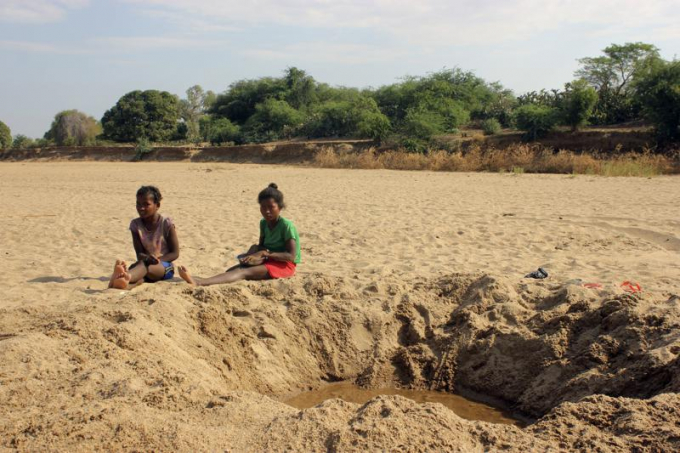May 22, 2025 | 16:09 GMT +7
May 22, 2025 | 16:09 GMT +7
Hotline: 0913.378.918
May 22, 2025 | 16:09 GMT +7
Hotline: 0913.378.918

FILE - In this Nov. 11, 2020, file photo, children sit by a dug out water hole in a dry river bed in the remote village of Fenoaivo, Madagascar. Lola Castro, WFP’s regional director in southern Africa, told a news conference Friday, June 25, 2021, that she witnessed “a very dramatic and desperate situation” during her recent visit with WFP chief David Beasley to the Indian Ocean island nation of 26 million people. (AP Photo/Laetitia Bezain, File)
Lola Castro, WFP’s regional director in southern Africa, told a news conference Friday that she witnessed “a very dramatic and desperate situation” during her recent visit with WFP chief David Beasley to the Indian Ocean island nation of 26 million people.
Hundreds of adults and children were “wasted,” and hundreds of kids were skin and bones and receiving nutritional support, she said.
In 28 years working for WFP on four continents, Castro said she had “never seen anything this bad” except in 1998 in Bahr el-Gazal in what is now South Sudan.
The U.N. and Madagascar’s government are launching an appeal for about $155 million in a few days to provide life-saving food and prevent a major famine, she said. Thousands of people have left their homes in rural areas and moved to more urban environments in search of food, she added.
Beasley tweeted Friday that 400,000 people are “marching towards starvation,” 14,000 are “in famine-like conditions,” and “if we do not act ASAP, the number of people facing starvation will reach 500,000 in a few short months.”
“Families have been living on raw red cactus fruits, wild leaves and locusts for months now,” he said Wednesday.
“This is not because of war or conflict, this is because of climate change,” Beasley stressed. “This is an area of the world that has contributed nothing to climate change, but now, they’re the ones paying the highest price.”
According to WFP, 1.14 million people in southern Madagascar don’t have enough food including 14,000 in “catastrophic” conditions, and this will double to 28,000 by October.
Madagascar is the only country that isn’t in conflict but still has people facing “Famine-Humanitarian Catastrophe” in the Integrated Food Security Phase Classification known as the IPC, which is a global partnership of 15 U.N. agencies and international humanitarian organizations that uses five categories to measure food security, Castro said.
AP

(VAN) Attempts to bring down the price of the Japanese staple have had little effect amid a cost-of-living crisis.

(VAN) Fourth most important food crop in peril as Latin America and Caribbean suffer from slow-onset climate disaster.

(VAN) Shifting market dynamics and the noise around new legislation has propelled Trouw Nutrition’s research around early life nutrition in poultry. Today, it continues to be a key area of research.

(VAN) India is concerned about its food security and the livelihoods of its farmers if more US food imports are allowed.

(VAN) FAO's Director-General emphasises the need to work together to transform agrifood systems.

(VAN) Europe is facing its worst outbreak of foot-and-mouth since the start of the century.

(VAN) The central authorities, in early April, released a 10-year plan for rural vitalization.